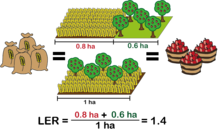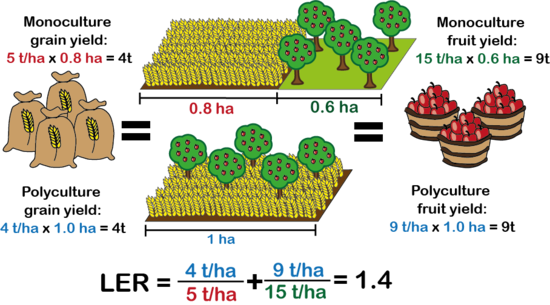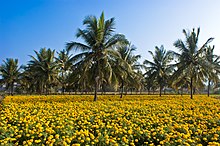The land equivalent ratio is a concept in agriculture that describes the relative land area required under sole cropping (monoculture) to produce the same yield as under intercropping (polyculture).
Definition

The FAO defines land equivalent ratio (LER) as:
the ratio of the area under sole cropping to the area under intercropping needed to give equal amounts of yield at the same management level. It is the sum of the fractions of the intercropped yields divided by the sole-crop yields.
For a scenario where a total of crops are intercropped, the land equivalent ratio LER can be calculated as
where is the number of different crops intercropped, is the yield for the crop under intercropping, and is the yield for the crop under a sole-crop regime on the same area.
Example calculation

The table in this section provides yield values for a hypothetical scenario intercropping a grain crop with a fruit tree crop.
The first two columns state the yields for intercropping (IY) and sole yields (SY). The third column, equivalent area, column calculates the area of sole cropping land required to achieve the same yield as 1 ha of intercropping, at the same management level.
| Crop | Intercropped Yield IY (kg/ha) | Sole Yield SY (kg/ha) | Equivalent area (ha) |
|---|---|---|---|
| Grain | 4,000 | 5,000 | 0.8 |
| Fruit | 9,000 | 15,000 | 0.6 |
| Land equivalent ratio | 1.4 | ||
The land equivalent ration can be calculated as
An interpretation of this result would be that a total of 1.4 ha of sole cropping area would be required to produce the same yields as 1 ha of the intercropped system.
Applications


The land equivalent ratio can be used whenever more than one type of yield can be obtained from the same area. This can be intercropping of annual crops (e.g. sorghum and pigeonpea) or combination of annual and perennial crops e.g. in agroforestry systems (e.g. jackfruit and eggplant).
It is also possible to calculate LERs for combinations of plant and non-plant yields, e.g. in agrivoltaic systems.
The table below lists some examples for land equivalent ratios published in scientific journals:
| Crops | Country/region | LER | Source |
|---|---|---|---|
| eggplant, jackfruit | Bangladesh | 2.17 | |
| cocoa, coconut | Mexico | 1.36 | |
| solar electricity, maize | Italy | 1.23 - 2.05 | |
| ginger, maize, soybean | Nepal | 2.45 | |
| maize, cowpea | Nepal | 1.58 | |
| millet, soybean | Nepal | 1.40 |
References
- ^ Mead, R.; Willey, R. W. (3 October 2008). "The Concept of a 'Land Equivalent Ratio' and Advantages in Yields from Intercropping" (PDF). Experimental Agriculture. 16 (3): 217. doi:10.1017/S0014479700010978. S2CID 84769811.
- Guidelines: land evaluation for irrigated agriculture. Food and Agricultization of the United Nations. pp. Glossary. ISBN 92-5-102243-7.
- ^ Rahaman, Md. Abiar; Rahman, Atiqur; Miah, Md. Giashuddin; Hoque, Md. Azizul; Rahman, Md. Mezanur (27 February 2018). "Productivity and Profitability of Jackfruit-Eggplant Agroforestry System in the Terrace Ecosystem of Bangladesh". Turkish Journal of Agriculture - Food Science and Technology. 6 (2): 124. doi:10.24925/turjaf.v6i2.124-129.1330.
- Majumdar, Debaleena; Pasqualetti, Martin J. (February 2018). "Dual use of agricultural land: Introducing 'agrivoltaics' in Phoenix Metropolitan Statistical Area, USA". Landscape and Urban Planning. 170: 150–168. doi:10.1016/j.landurbplan.2017.10.011.
- Amaducci, Stefano; Yin, Xinyou; Colauzzi, Michele (June 2018). "Agrivoltaic systems to optimise land use for electric energy production". Applied Energy. 220: 545–561. doi:10.1016/j.apenergy.2018.03.081. S2CID 116236509.
- ^ Chapagain, Tejendra; Pudasaini, Roshan; Ghimire, Bhawana; Gurung, Khem; Choi, Khem; Rai, Laxmi; Magar, Samjhana; BK, Bishnu; Raizada, Manish N. (October 2018). "Intercropping of maize, millet, mustard, wheat and ginger increased land productivity and potential economic returns for smallholder terrace farmers in Nepal". Field Crops Research. 227: 91–101. doi:10.1016/j.fcr.2018.07.016. S2CID 92717782.

 crops are intercropped, the land equivalent ratio LER can be calculated as
crops are intercropped, the land equivalent ratio LER can be calculated as

 is the yield for the
is the yield for the  crop under intercropping, and
crop under intercropping, and  is the yield for the
is the yield for the 